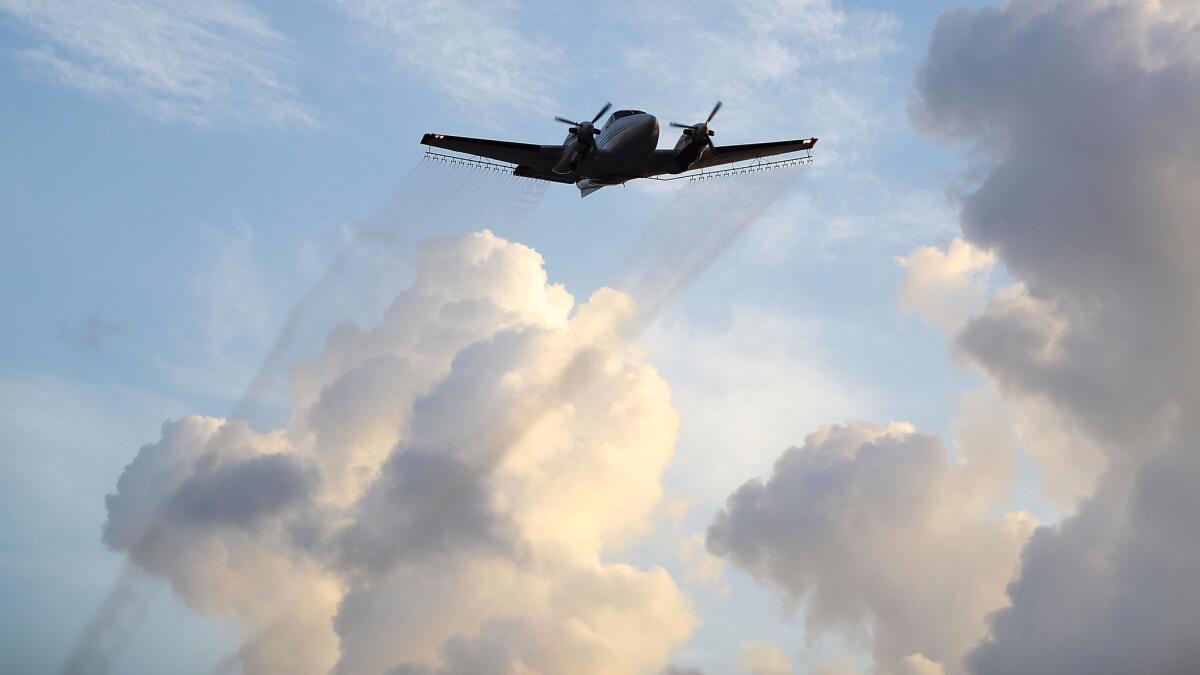Zika didn’t drive her from Miami Beach — but questions about the pesticide being used to stop it did

- Share via
Zika’s arrival in Miami Beach didn’t drive away Miriam Haskell, who is pregnant with her first child. But her questions about one of the chemicals being used to combat the mosquitoes that are spreading the virus did.
Last week, the 36-year-old public interest lawyer packed up and flew to Atlanta, where she plans to stay with a friend until planes stop spraying the insecticide naled over her neighborhood.
She is not alone in her fears.
Naled has been banned in the European Union since 2012, and the governor of Puerto Rico refused to allow aerial spraying with the insecticide in the fight against Zika this summer.
In Miami-Dade County, the only region on the U.S. mainland with confirmed local transmission of Zika, some believe naled poses greater risks to people and wildlife than the virus itself.
Concerned residents and environmental activists have been holding demonstrations outside the Miami Beach town hall to protest weekly aerial spraying that began this month.
They filled a recent city commission meeting, booing and jeering elected officials who argued that the region is facing a public health emergency and must use every tool available to halt the spread of a virus that can cause severe neurological defects in babies born to women infected during pregnancy.
For Haskell, it’s not a question of which is more dangerous. “I have felt like I can personally take precautions against Zika,” she said.
She stayed indoors in her air-conditioned apartment and used a car to get to her air-conditioned office. When she had to be outside, she put on pants and long-sleeved shirts and applied mosquito repellent.
But she did not know what, if anything, she should do to protect herself from naled.
The Environmental Protection Agency says the insecticide, which has been registered for use in the United States since 1959, does not pose risks to people when it is applied according to label instructions.
“I just don’t have any information on how to gauge that,” Haskell said.
She was also alarmed to read that millions of bees were killed when they were exposed to naled during spraying in South Carolina in August.
“I can only make a decision that is best for me,” Haskell said. “I understand that the county has to make a decision that is best for everyone in it — I hope that they are taking things like the environmental impact into account.”
How dangerous is the insecticide? Here is what we know:
How does naled work?
When naled is sprayed, fine droplets drift through the air and kill adult mosquitoes on contact. It does this by inhibiting an enzyme called acetylcholinesterase, which is critical for controlling nerve signals.
Humans — along with most animals — also have the enzyme targeted by naled.
Is it safe?
“Everything can be toxic,” says Keith Solomon, a professor emeritus at the University of Guelph in Canada who researches the effects of pesticides in the environment. “It’s the dose that makes the poison.”
If exposed to large enough amounts of naled, people can suffer confusion, dizziness or nausea. Severe poisoning can even cause convulsions, respiratory failure and death.
But according to the EPA and the Centers for Disease Control and Prevention, aerial spraying in the United States is done in ultra-low volumes — about an ounce, or two tablespoons, per acre. At those levels, people aren’t likely to breathe in, touch or ingest anything with enough insecticide on it to harm them, Solomon said.
Even before Zika arrived, naled was widely use for mosquito control in Florida. Nearly 6 million acres of land in the state were sprayed with the pesticide in 2014 alone, the CDC says.
Still, the EPA and CDC say it is a good idea to reduce unnecessary exposure to pesticides whenever possible. Those who tend to be sensitive to chemicals might experience short-term effects, such as irritation to the eyes, skin and nose.
The bigger danger, however, is to other insects, including bees that are needed to pollinate crops and flowers. The EPA recommends covering up hives or, if possible, moving them during aerial spraying.
Mosquito-control teams from Miami-Dade County have been spraying at dawn, when most people are at home and bees are less likely to be foraging. Winds also tend to be lower at that time, so there is less chance that the insecticide will spread outside the target area, Solomon said.
Although naled does pose some risk to aquatic invertebrates, such as shrimp and water fleas, and to terrestrial wildlife, studies have found that it dissipates rapidly in sunlight and water and does not persist in the environment.
If the EPA is right, why is naled banned in the EU?
The EU decision cited “a potential and unacceptable risk” to human health and the environment. It also said that officials weren’t persuaded that the chemical is effective enough.
The EPA disagrees with that assessment. It is required by law to consider not only the risks, but also the benefits of allowing an insecticide to be used, something that was not discussed in the EU decision.
Europe does not currently have a problem with mosquitoes spreading the Zika virus.
“I suspect that if Zika were to arrive in Europe and become locally transmitted, that they would probably consider lifting their ban on aerial application,” Solomon said.
Can’t they do something else?
There is no vaccine or treatment for Zika, so the only way to contain an outbreak is to go after the mosquito species that spreads the virus: Aedes aegypti.
It’s a wily adversary. Experts recommend using a combination of strategies, including draining or covering pools of standing water where mosquitoes breed, installing screens on windows and doors, and spraying with insecticides that kill adult mosquitoes and their larva.
In Miami-Dade County, mosquito control agents have used two types of pyrethroid insecticides that are sprayed using equipment carried in backpacks or mounted on trucks. But Dr. Thomas Frieden, the CDC director, told reporters at the beginning of August that those methods weren’t working as well as hoped, and the mosquito species might be resistant to the chemicals.
CDC officials credit the decision to begin aerial spraying of naled, which targets adult mosquitoes, and Bti, a bacterial agent that kills larva, with rapidly reducing the Aedes aegypti population in Miami’s Wynwood district.
No new cases of mosquito-spread Zika have been reported in the area, the first in the county where local transmission was confirmed, since early August.
But in Miami Beach, the area of concern was expanded last week from roughly 1.5 square miles to 4.5 square miles after a cluster of new Zika cases was discovered.
Another round of aerial spraying is planned there Saturday.
Twitter: @alexzavis
More to Read
Sign up for Essential California
The most important California stories and recommendations in your inbox every morning.
You may occasionally receive promotional content from the Los Angeles Times.










